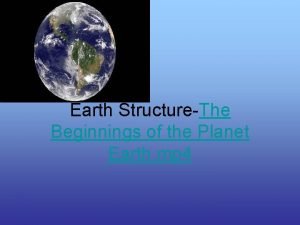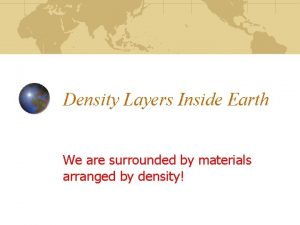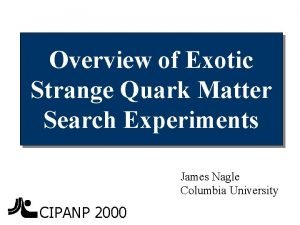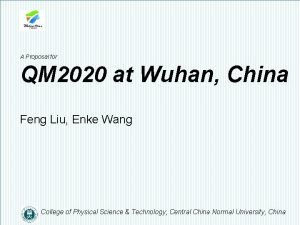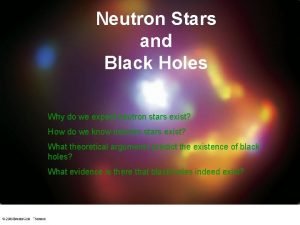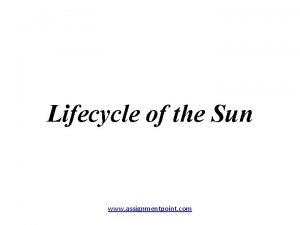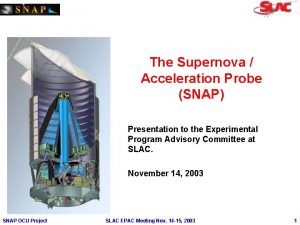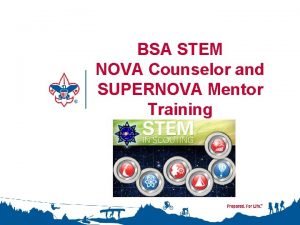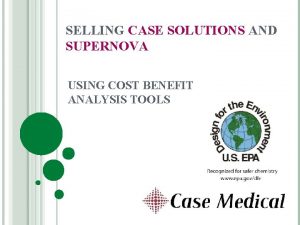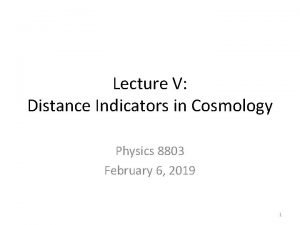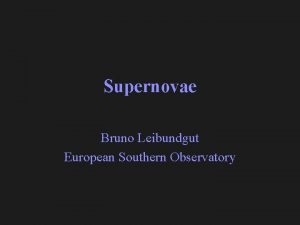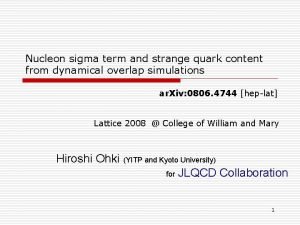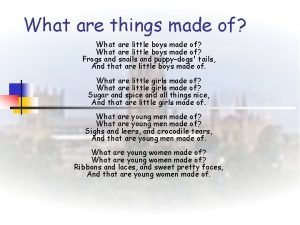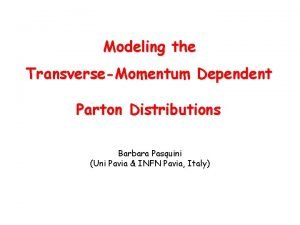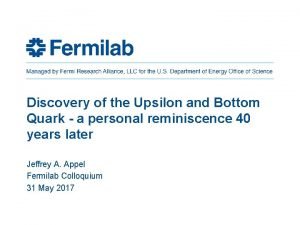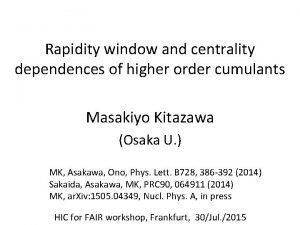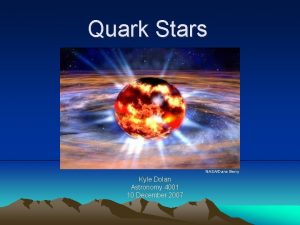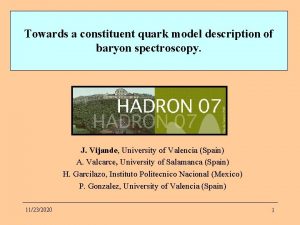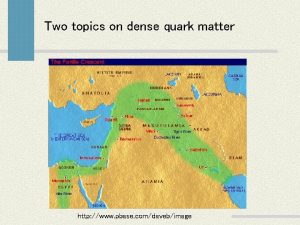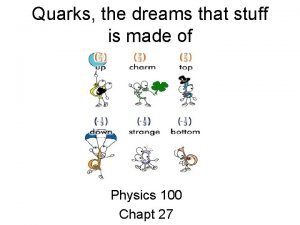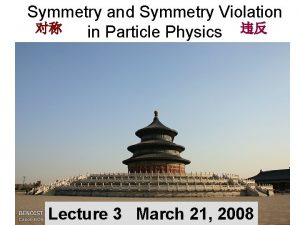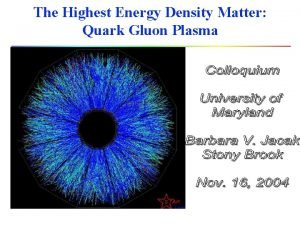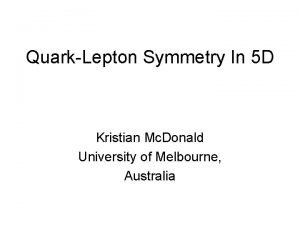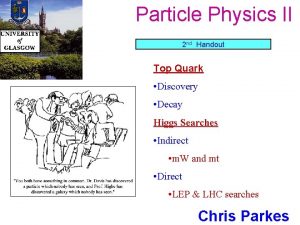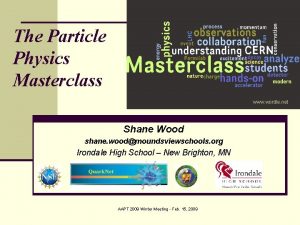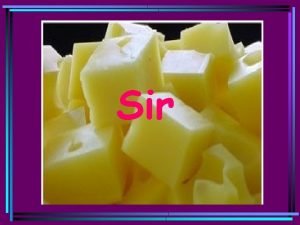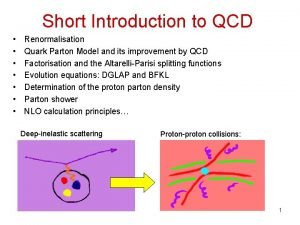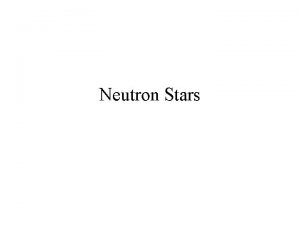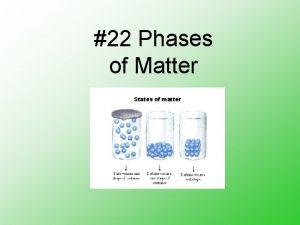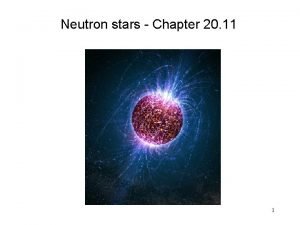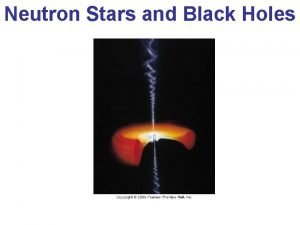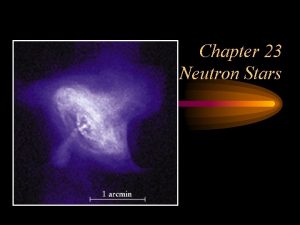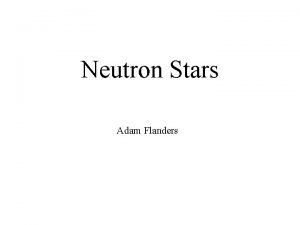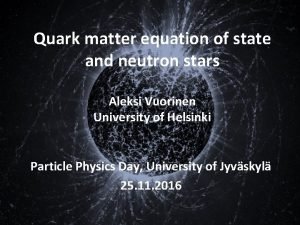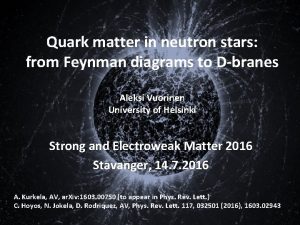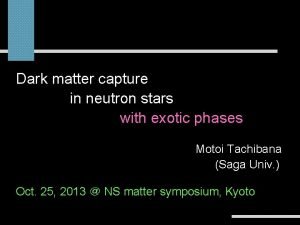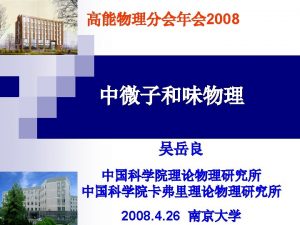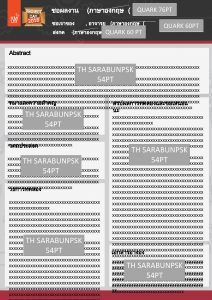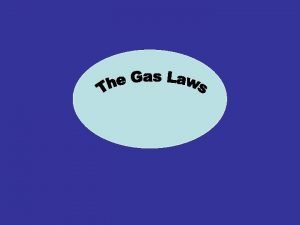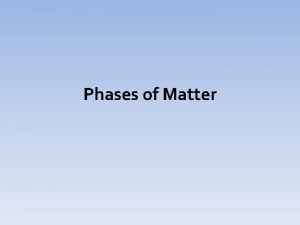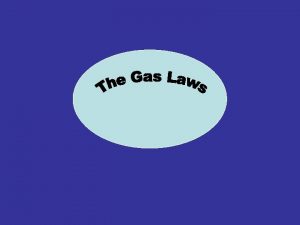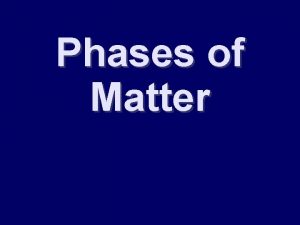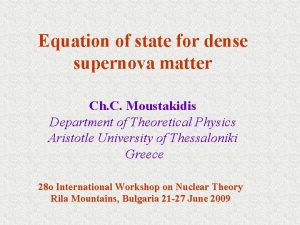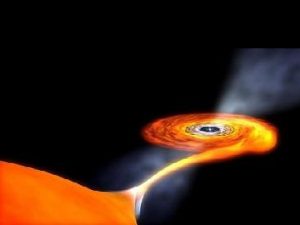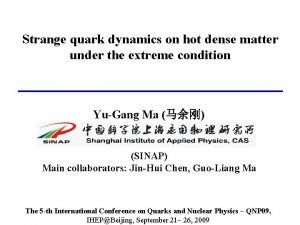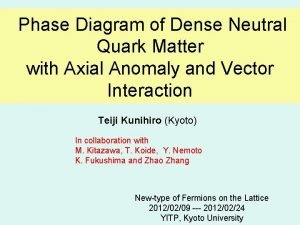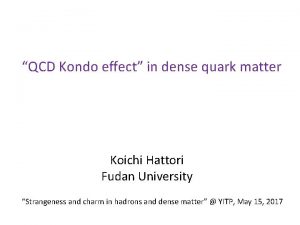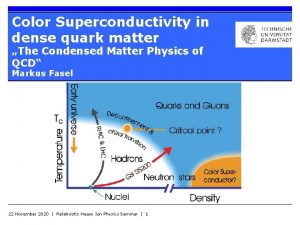Neutron Stars Supernova Phases of Dense Quark Matter





























- Slides: 29

Neutron Stars, Supernova & Phases of Dense Quark Matter Seeking observable signatures for dense quark matter in astrophysics Sanjay Reddy Theoretical Division, LANL

Observables: (sensitive to the high density physics) • • • Mass and Radius Supernova Neutrinos Surface Temperature and Age Spin period ( and d /dt) Gravity Waves Hard Physics: E ~ ~ 400 Me. V Soft Physics: E ~ T ~ 10 -3 -50 Me. V

Neutron Star Mass §Origin of the clustering at MNS~1. 4 Msolar ? §Physics issue : Eo. S at high density what is the heaviest neutron stars one can make ? Courtesy: J. Lattimer

Radius: L∞ =F d 2 =4 R∞ 2 T∞ 4 RX J 1856 -3754: nearby (d~120 pc) isolated neutron star

Radius: L∞ =F d 2 =4 R∞ 2 T∞ 4 Deviations from Blackbody spectra: atmosphere: sensitive to local gravity (GM/R 2) Potentially can yield both M and R Pons et al. Astrophys. J. 564: 981 -1006, 2002 Walter & Lattimer, Astrophys. J. 576: L 145 -L 148, 2002

Constraints and Trends: Exotic Stars: Soft Eo. S Quasi-Periodic Oscillations: indicate a last stable orbit Gravitational Red-shift: observation of spectral lines (Cottam, Paerels, Mendez, Nature 420: 51 (2002).

Phases of Dense Quark Matter §Attractive interactions destabilize the Fermi surface formation of cooper-pairs (BCS Theory) §In quark matter most attractive channel is antisymmetric in color space spin zero pairs must be anti-symmetric in flavor 2 -flavor quark matter: (2 SC) u d u d Rapp, Schaefer, Shuryak, and Velkovsky Phys. Rev. Lett. 81, 53 (1998) Alford, Rajagopal, Wilczek Phys. Lett. B 422, 247 -256, (1998) 100 Me. V

Color-Flavor Locked Phase Alford, Rajagopal & Wilczek, Nucl. Phys. B 558, 219 (1999) Energy BCS pairing of all 9 quarks: 100 Me. V ! Excitation Spectrum

PF Charge Neutrality in Dense Quark Matter Normal Quark Matter requires electrons for charge neutrality breaks iso-spin u d s CFL requires ms 2/4 e. Alford, Rajagopal, Reddy and Wilczek Phys. Rev. D 64: 074017, (2001)

Less symmetric phases: (when three is a crowd) Neutrality favors CFL 2 Normal 2 SC CFLKo CFL Alford & Rajagopal, hep-ph/0204001 Steiner, Reddy, Prakash hep-ph/0205201 4 Bedaque , Schafer Nucl. Phys. A 697: 802 -822, (2002) Kaplan, Reddy, Phys. Rev. D 65: 054042, (2002) Alford, Kouvaris, Rajagopal, hep-ph/0311286 Shovkovy , Huang, Phys. Lett. B 564: 205, (2003)

Heterogeneous Mixed Phases (phase transitions with 2 conserved charges) Glendenning, Phys. Rev. D 46: 1274 -1287, 1992 Sharp (polarized) interface : Large density discontinuity D A B/C Heterogeneous co -existence line: (droplets-rodsslabs) Alford, Rajagopal, Reddy and Wilczek Phys. Rev. D 64: 074017, (2001)

Quark Matter Eo. S & Hybrid Stars Alford & Reddy, Phys. Rev. D 67 074024 (2003)

Can Quark Stars Mimic Nuclear Stars ?

Core Collapse Supernova • Fe core becomes unstable • Collapse time scale ~ 100 ms • Nearly Adiabatic • B. E. ~ G Mcore/Rfinal ~3 X 1053 ergs

Supernova Neutrinos - a (proto) neutron star is born 1500 km Core collapse tcollapse ~100 ms 3 X 107 km B. E. ~2 -3 X 1053 ergs Shock wave Eshock~1051 ergs 10 km Hot & dense Proto-neutron Star: t~1 -2 s 100 km

Proto-Neutron Star Evolution 3 1053 ergs is stored in neutrinos and internal energy.

Proto-neutron Star Phase: late times (t > 3 -4 s) Burrows & Lattimer, Astrophys. J 307, 178 (1986) Kiel & Janka, Astrnm. & Astrophys. 296, 145 (1995) Pons, Reddy, Prakash, Lattimer, Miralles, Astrophys. J. 513, 780 (1999) • Neutrino diffusion dominates evolution • Time scales set by neutrino mean free path and dense matter Eo. S Reddy, Prakash, Lattimer, Pons Phys. Rev. C 59, 2888 (1999)

simulations with normal quark matter Delayed collapse to black-holes: Generic to most high density transitions to very soft Eo. S. Pons, Steiner, Prakash and Lattimer, Phys. Rev. Lett. 86, 5223 (2001)

Microphysics of neutrino mean free paths E E’ q E q target

Neutrino Mean Free Path in Nuclear Matter Horowitz & Wehrberger, Phys. Lett. B 266, 236 (1991) Burrows & Sawyer, Phys. Rev. C 58, 554 (1999) Reddy, Pons, Prakash, Lattimer, Phys. Rev. C 59, 2888 (1999)

Neutrino Mean Free Path in a Heterogeneous Phase Coherent Scattering: enhances cross sections ’ QW~200 Reddy, Bertsch & Prakash, Phys. Lett. B 475, 1 (2000)

Neutrino Propagation in Superconducting phases p+q p + p+q p Gap modifies excitation spectrum Carter & Reddy, Phys. Rev. D 62, 103002 (2000)

Effective theory for Goldstone modes: Schafer Phys. Rev. D 65, 074006 (2002) Manuel & Tytgat, Phys. Lett. B 479, 190 (2000) Hong, Lee & Min, Phys. Lett. B 477, 137 (2000) Hong, Phys. Lett. B 473, 118 (2000) Son & Stephanov, Phys. Rev. D 61, 074012 (2000)

Neutrino-Goldstone Boson Interactions o Z - e- W- Z W e Reddy, Sadszikowski & Tachibana, Nucl. Phys. A 714, 337 (2003) Jaikumar, Prakash & Schafer, Phys. Rev. D 66, 063003 (2002)

Goldstone modes are space-like ( < q) o + e G F f ’ G F f e- Neutrinos can Cerenkov radiate Goldstone modes

Neutrino-Goldstone Boson Interactions Reddy, Sadszikowski & Tachibana, Nucl. Phys. A 714, 337 (2003)

Neutron Star Cooling Crust cools by conduction C~1 -10 yrs, R ~ 0. 5 -2 km Isothermal core cools by neutrino emission t < 105 yrs TS~106 K Photon emission Standard (slow) Cooling: nn npe- e & np nne+ e d. E/dt 1022 (ne/no)1/3 T 98 erg/cm 3/s Rapid Cooling: (np/n. B > 1/9) n pe- e & e-p n e d. E/dt 1027 (ne/no)1/3 T 96 erg/cm 3/s

Neutron Star Cooling: Data “Standard” (slow) cooling: nn->npe Rate ~1022 T 98 erg/cm 3/s Exotic (fast) cooling: n -> p e- & d -> u e- Rate ~1027 T 96 erg/cm 3/s Tsuruta et al. Ap. J. 571, L 143 (2002)

Outlook • Observation of a small star (R 8 km) would favor a soft quark Eo. S / Observation of a heavy star ( M 2 M ) would disfavor quark matter. • Hadron quark transition density is poorly known • Role of the strange quark mass (and neutrality) important phase structure not fully understood • Neutrino diffusion time scale is sensitive to properties of matter at supra-nuclear density Supernova neutrinos - a promising probe • Need neutrino rates and thermodynamics at finite T in less “symmetric” quark phases (Gapless CFL, 2 SC, Gapless 2 SC, unpaired quark matter, mixed phases etc)
 What are the 3 main layers of the earth? *
What are the 3 main layers of the earth? * Earth's layers most dense to least dense
Earth's layers most dense to least dense Earth's layers most dense to least dense
Earth's layers most dense to least dense Color quarks
Color quarks Quark matter 2022
Quark matter 2022 Anatomy of a star
Anatomy of a star Supernova
Supernova Supernova acceleration probe
Supernova acceleration probe Supernova mentor
Supernova mentor Steris decontamination sinks
Steris decontamination sinks Supernova spectra
Supernova spectra Bruno leibundgut
Bruno leibundgut There are millions of stars in the sky
There are millions of stars in the sky Sigma quark composition
Sigma quark composition Quark names
Quark names Quark model
Quark model Quark names
Quark names Quark gluon plasma
Quark gluon plasma Quark astronomy
Quark astronomy Constituent quark model
Constituent quark model Quark gluon
Quark gluon 6 types of quarks
6 types of quarks Quark gluon
Quark gluon A charm quark has a charge of approximately
A charm quark has a charge of approximately Quark gluon
Quark gluon Quark lepton symmetry
Quark lepton symmetry Top quark decay
Top quark decay Quark physics wordle
Quark physics wordle Zamjena za kačkavalj sir
Zamjena za kačkavalj sir Quark parton model
Quark parton model

